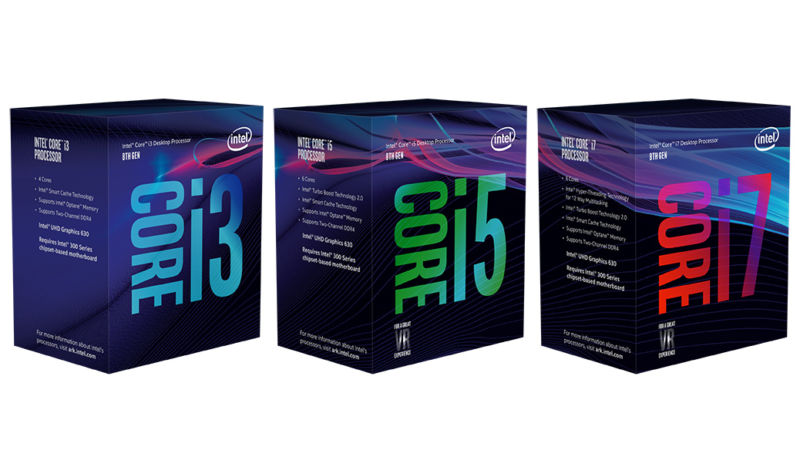
Coffee Lake desktop processors, the follow up to 2016's Kaby Lake processors, launch on October 5, Intel announced today. Like the recent U-series Kaby Lake Refresh laptop processors, which also launched under the "8th generation" moniker, Coffee Lake is largely based on the same core 14nm architecture as Kaby Lake, which in turn was essentially just Skylake, but with more cores across the range.
The top-of-the-line 17-8700K features six cores and 12 threads, 12MB of L3 cache, and a boost clock up to 4.7GHz. The i5-8600K keeps the six physical cores, but ditches hyperthreading, while the i3-8100 and i3-8350K both feature four physical cores. The latter, which matches the core count of the older i5 7600K, could prove to quite the bargain for gamers on a budget, particularly as it's unlocked for overclocking.
Previously, Intel processors with more than four cores fell under the high-end-desktop (HEDT) E-series and X-series ranges, which cost significantly more than mainstream processors. Unfortunately, while Coffee Lake is more affordable than an X299 chip—the questionable quad-core i5-7640X and i7-7740X excluded, prices are higher than Kaby Lake across the board.
The i7-8700K costs $359, up from the $305 launch price of the i7-7700K, while the i5-8600K costs $257, up from the $217 of the i5-7600K. Bear in mind that these are that these per chip in a 1000 unit order prices—expect retail to be higher still. Coffee Lake also requires the new Z370 chipset, which features improved power delivery in order to support processors with more cores. There's also official support for DDR4-2666MHz memory.
Those that can make use of the extra cores should see a significant increase in performance in multuthreaded workloads. Intel claims Coffee Lake offers up to 25 percent more FPS in games, and 45 percent more performance during "mega-tasking" compared to the Core i7-7700K. Intel is keen to stress how good its processors are at gaming, attacking one of the criticisms levelled at AMD's Ryzen processors.
Notably, Intel's quoted boost clocks are for Turbo Boost 2.0, which means all six cores should hit 4.7GHz when using a motherboard's built-in multicore enhancements. That's a very high out-of-the-box clock speed for a six-core processor, one that should result in some interesting gaming benchmarks.
While the i7-8700K makes the X299-based i7-7800X somewhat redundant, the Z370 platform does suffer from the same limitations as its predecessor Z270. There's only support for dual-channel memory, and there are only 16 PCIe lanes connected directly to the CPU. The platform as a whole supports up to 40, but those extra 24 share a single DMI 3.0 connection to the CPU, which can limit performance, particularly in systems with multiple M.2 NVMe storage drives.
Like Kaby Lake, Coffee Lake also features integrated GPUs across the board, which is handy for those need the processing power, but only have modest GPU requirements (current Ryzen CPUs all require a discrete GPU). Unfortunately, there are no significant improvements to speak of on the GPU side, with all CPUs featuring Intel UHD 630 graphics, which are largely unchanged from Intel 530 graphics.
While Coffee Lake is unlikely to offer a significant IPC improvement over Kaby Lake, that there are finally mainstream Intel processors with more than four cores is welcome. Ars will have a review soon, but for now read the Core i9-7960X review, which pits Intel's 16-core chip against AMD's 16-core Threadripper.
reader comments
104